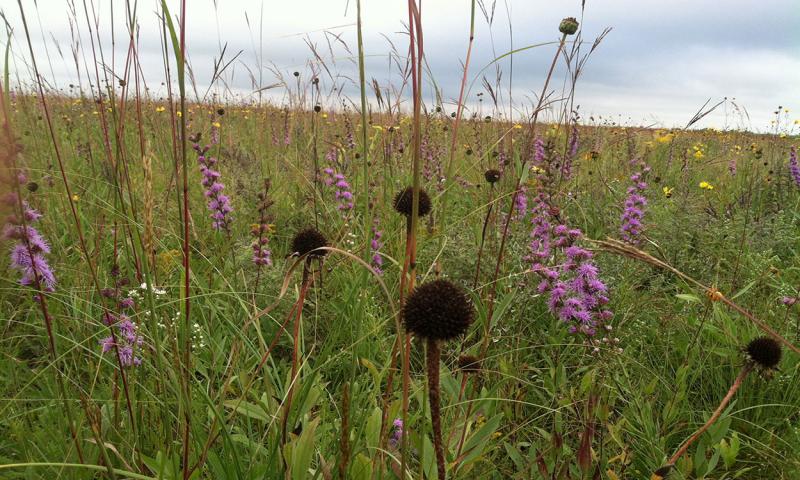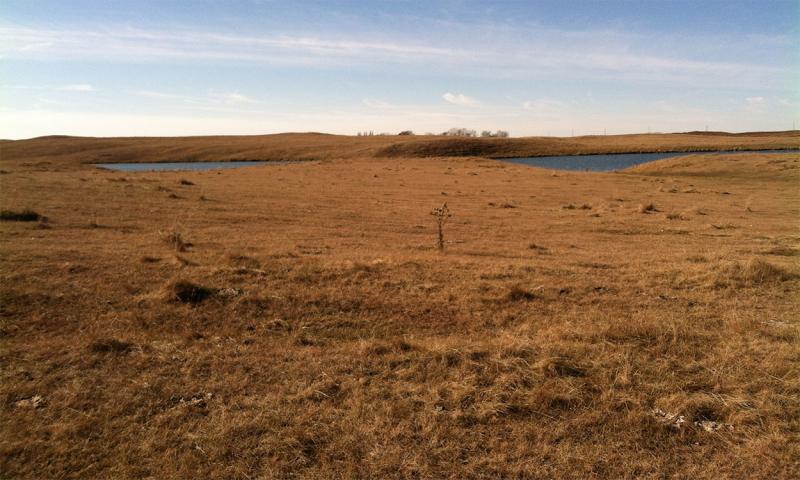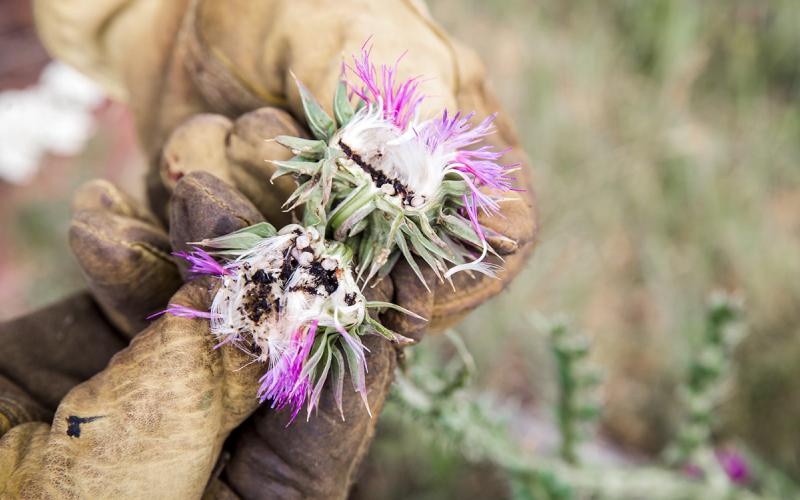
Written collaboratively by Pete Bauman, Karla Hernandez and Sandy Smart.
In the first two articles of this series on nitrogen fertilization, we introduced the background information on the overall terms, economics and ecological effects of nitrogen in plant communities. We encourage you to review those articles.
While nitrogen fertilization of native grasslands can potentially increase production in the short-term, it is generally assumed to be detrimental to the overall long-term health of the plant community. It is rare to find any grassland in South Dakota, native or otherwise, that doesn’t have some level of infestation of non-native invasive grasses, such as smooth bromegrass, Kentucky bluegrass and cheatgrass. Even our best native pastures, rangelands and prairies suffer from at least some level of invasion. Within this reality lies a wide gradient of quality of the native grasslands that is largely influenced by past and present management.

In healthy native grasslands with only limited invasion of non-native grasses (Figure 1), nitrogen fertilization will likely bolster the competitive advantage of the undesirable invasive grasses. This, in turn, will negatively impact the plant community, likely leading to a reduction and possible elimination of certain native plants from the system over time. In addition, once the invasive species gain a competitive advantage, they will likely continue to self-propagate and gain dominance in the community, leading to additional decreases in native plant variety and richness.
In native pastures already dominated by invasive non-native grasses, such as smooth brome, nitrogen fertilization will likely increase production, but it may have lasting negative effects on the plant community—driving an already unbalanced system further toward single-species dominance. In turn, this simplification of the plant community can severely limit the pasture’s resiliency to changing environmental conditions, such as drought, thus restricting the pasture’s use to certain seasons (Figure 2).
While there is a great deal of anecdotal information related to fertilization of grasslands in South Dakota, there is limited information from studies designed to look specifically at the effects of fertilizing native pastures. Those studies that have taken place have been relatively small, isolated, and, while occasionally incorporating native pastures, the quality of those pastures has been generally degraded and/or highly invaded with cool-season exotic species, such as Kentucky bluegrass and smooth bromegrass. We found no studies where nitrogen fertilizer was applied to pristine native grasslands. These studies are likely lacking, because those types of grasslands are often managed by individuals already aware of the harmful effects artificial nitrogen applications can have on a native plant community, and thus do not/will not conduct such experiments. Part four of this series will highlight an additional native pasture case study that took place in Hamlin County.
Case Study One: Leola Area, McPherson County
Fertilizer Nitrogen and Phosphorus Influence on Pasture Yield in McPherson County, South Dakota in 2004
Case Study One was conducted in 2004 by South Dakota State University (SDSU) researchers on two pasture sites near Leola in McPherson County. The study did not indicate whether the pastures were truly native sod. Pasture site one was dominated by Kentucky bluegrass with native and introduced broadleaf plants. Pasture site two was dominated by all introduced species, including intermediate wheatgrass, smooth bromegrass and alfalfa, making its classification as native pasture highly suspect. Therefore, site one is included in this section on native grasslands (Results from site two are included in Case Study Five in this series associated with non-native planted grasslands).
At site one, where Kentucky bluegrass dominated the pasture, researchers fertilized with urea (46-0-0) and triple super phosphate (0-46-0). Phosphorus was applied at 40 pounds/acre and increased dry matter production from 2,580 to 3,121 pounds/acre (+540 pounds /acre). Application rates for nitrogen (N) at site one were 0, 30, 60, 90 and 120 pounds/acre. Production was 2,115 pounds/acre without N application. Yield rose consistently up to a maximum of 4,706 pounds/acre where N application was 120 pounds/acre. Yield only increased between no fertilization and 30 pounds N to 2,280 pounds/acre and then again to 4,127 pounds/acre when 90 pounds of N were applied. See the interpretation portion of Case Study Two below for a discussion on valuing total forage produced against the amount of forage actually available to livestock.
Interpretation
No information was provided regarding the composition of the yield data in relation to plant species. It is assumed that with site one being dominated by Kentucky bluegrass, this is likely the dominant species in the yield trial. No information was provided on invasive species or post-trial plant community characteristics. It is assumed that in degraded pasture systems, such as this, N application will only perpetuate the dominance of Kentucky bluegrass.
Reference: Gerwing et al. 2004
Case Study Two: Deuel, Grant and Clark Counties
2004–2009 Northeast South Dakota Pasture Fertilization Trials
Case Study Two was conducted by SDSU Extension in Deuel, Grant and Clark counties in 2004, 2005 and 2009, and it was focused on measuring yield increases and economic return from application of N and phosphorus (P) at various rates. The authors indicated that, while these trials were conducted on what was determined to be native pastures/hay land, all sites were fairly heavily infested with non-native invasive grasses, such as smooth bromegrass and Kentucky bluegrass, with limited native grass component (Langner. Personal communication.). Further, these sites were selected for the study specifically because they had a heavy influence of introduced grass species that were known to respond well to N applications.
The authors indicated the following market prices at the time the study data was compiled (2009). Grass hay $75/ton, 46-0-0 N $475/ton ($0.52/pounds) and 18-46-0 P $510/ton ($0.55/pounds). For comparison, today’s prices are approximately $100–$120/ton for fair-to-good grass hay, 46-0-0 N at $455/ton ($0.49/pounds) and 18-46-0 P is $550/ton ($0.60/pounds). No study methodology was provided, but the investigators indicated that five trial plots were non-randomly located within each pasture (Langner. Personal communication). Plots were in close proximity to one another, and livestock was fenced out of the trial plots during the growing season.
Interpretation
Generally, as fertilizer application rates increased, so did overall vegetative production. Researchers indicated that, while productivity increased with fertilizer applications, weed infestations also increased across all sites (Langner. Personal communication). This increase in invasive species required additional inputs associated with weed control, thus impacting the actual profitability that might have been realized at various application rates. However, weed control costs were not estimated.
Further, and perhaps more important, is the need to understand that not all increased forage production results in actual forage consumed by the animal. The results of this fertilization trial are reported in Table 1 below. The 135-60 application yielded the greatest average total pounds/acre (7,333 pounds) and the greatest yield over the baseline control plot (5,255 pounds). However, in a grazing situation with roughly 30% harvest efficiency, only 1,576 pounds of the 5,225 pounds increased production is actually consumed by the animal. In reality, the additional 1,576 pounds/acre of forage cost, at today’s fertilizer prices, $102.64/acre to produce, resulting in a final cost of feeding equivalent to roughly $130/ton. At that rate of investment, one would be better off purchasing hay than to rely on fertilizer to produce additional forage for grazing.
However, in a hay harvest situation at 80% harvest efficiency, one might be able to harvest up to 4,204 pounds/acre over the baseline at a cost of $102.64/acre. This is equivalent to about $49/ton fertilizer investment into hay. This may be financially profitable in some years, assuming the risks of weedy infestations and potential degradation of the native plant community are taken into account. Finally, it is unlikely that 80% hay harvest efficiency can be achievable on most truly native pastures due to topography, access, rocks and other hindrances. In addition, hay harvest expenses must be considered as well when determining end profit.
A total average of 3,786 pounds/acre was produced in Case Study Two compared to the 4,127 pounds/acre recorded in Case Study One with the 90 pounds of N application rate. However, in reality, only an additional average of 512 pounds/acre was actually produced as available forage at a cost of $44.51/acre (today’s fertilizer cost equivalent). The final cost of the forage produced is $173/ton, significantly higher than even premium grass hay at today’s market prices.
Reference: Data derived from Maaland and Kruse 2004/2005 and Langner, McGraw, Schafer, Marxen and Guthmiller 2009.
| Fertilizer Treatment Ratio (N-P) |
Total Average Production Across All Sites (Lbs./acre) |
Total Lbs./Acre Available for Grazing at 30% Harvest Efficiency | Total Lbs./Acre Available for Haying at 80% Harvest Efficiency | Additional Lbs./Acre Produced Over Control | Actual Additional Lbs./Acre Available for Grazing at 30% Harvest Efficiency | Actual Additional Lbs./Acre Available for Haying at 80% Harvest Efficiency | Fertilizer $/Acre (2009) |
Fertilizer $/Acre (2015) Watertown, South Dakota Co-op |
|---|---|---|---|---|---|---|---|---|
| 0-0 Control Plot | 2,078 | 623 | 1,662 | 0 | 0 | 0 | $0.00 | $0.00 |
| 45-0 | 3,409 | 1,023 | 2,727 | 1,331 | 399 | 1,065 | $24.95 | $22.26 |
| 90-0 | 3,786 | 1,136 | 3,029 | 1,708 | 512 | 1,366 | $49.89 | $44.51 |
| 135-60 | 4,790 | 1,437 | 3,832 | 2,712 | 814 | 2,170 | $74.84 | $66.77 |
| 12-30 | 2,781 | 834 | 2,224 | 703 | 211 | 562 | $22.14 | $23.87 |
| 24-60 | 3,741 | 1,122 | 2,993 | 1,663 | 499 | 1,330 | $44.28 | $47.74 |
| 35-90 | 4,087 | 1,226 | 3,269 | 2,009 | 603 | 1,607 | $65.87 | $71.11 |
| 45-30 | 5,594 | 1,378 | 3,675 | 2,516 | 755 | 2,013 | $40.43 | $40.19 |
| 45-60 | 5,039 | 1,512 | 4,031 | 2,961 | 888 | 2,369 | $55.92 | $58.13 |
| 45-90 | 5,074 | 1,522 | 4,059 | 2,996 | 899 | 2,397 | $71.41 | $76.06 |
| 90-30 | 5,994 | 1,798 | 4,795 | 3,916 | 1,175 | 3,133 | $65.38 | $62.45 |
| 90-60 | 5,641 | 1,692 | 4,512 | 3,563 | 1,069 | 2,850 | $80.87 | $80.38 |
| 90-90 | 6,237 | 1,871 | 4,989 | 4,159 | 1,248 | 3,327 | $96.36 | $98.32 |
| 135-30 | 6,766 | 2,030 | 5,413 | 4,688 | 1,407 | 3,751 | $90.33 | $84.70 |
| 135-60 | 7,333 | 2,200 | 5,866 | 5,255 | 1,576 | 4,204 | $105.82 | $102.64 |
| 135-90 | 6,131 | 1,839 | 4,905 | 4,053 | 1,216 | 3,242 | $121.30 | $120.57 |
Modified from South Dakota State University (SDSU) Extension data.
Resources and References:
- Nutrient Network: Includes links to several articles on the topic.
- Alpert, P., E. Bone, and C. Holzapfel. 2000. Invasiveness, invisibility and the role of environmental stress in the spread of non-native plants. Perspectives in plant ecology, evolution, and systematics. 3:52-66.
- Borer, E.T., E.W. Seabloom, D.S. Gruner, W.S. Harpole, H. Hillebrand4, E.M. Lind1, P.B. Adler, J. Alberti, T.M. Anderson, J.D. Bakker, L. Biederman, D. Blumenthal, C.S. Brown, L.A. Brudvig, Y.M. Buckley, M. Cadotte, C. Chu, E.E. Cleland. M.J. Crawley, P. Daleo, E.I. Damschen, K.F. Davies, N.M. DeCrappeo, G. Du, J. Firn, Y. Hautier, R.W. Heckman, A. Hector, J. HilleRisLambers, O. Iribarne, J.A. Klein, J.M. H. Knops., K.J. La Pierre, A.D.B. Leakey, W. Li, A.S. MacDougall, R.L. McCulley, B.A. Melbourne, C.E. Mitchell, J.L. Moore, B. Mortensen, L.R. O’Halloran, J.L. Orrock, J. Pascual, S.M. Prober, D.A. Pyke, A.C. Risch, M. Schuetz, M.D. Smith, C.J. Stevens, L.L. Sullivan, R.J.Williams, P.D. Wragg, J.P. Wright, and L.H. Yang. 2014. Herbivores and nutrients control grassland plant diversity via light limitation. Nature. 00:1-4.
- Dickson, T.L. and B.L. Foster. 2011. Fertilization decreases plant biodiversity even when light is not limiting. Ecology Letters. 14:380-388.
- Foster, B.L., and K.L. Gross. 1998. Species richness in a successional grassland: effects of nitrogen enrichment and plant litter. Ecology. 79:2593-2602.
- Gerwing, J., A. Bly, L. Butler, D. Curtis, and G. Erickson. 2004. Fertilizer N and P influence on pasture yield in McPherson County SD in 2004 (projects 35004 and 35104). Soil/water research. South Dakota State University. 2004 progress report. Agriculture Experiment Station. Plant Science Department. Soil PR 04-7:1-3.
- Harpole, W.S., and D. Tilman. 2007. Grassland species loss resulting from reduced niche dimension. Nature. 446:791-793.
- Hautier, Y., P.A. Niklaus, and A. Hector. Competition for light causes plant biodiversity loss after eutrophication. 2009. Science. 324:636-638.
- Hautier, Y., E.W. Seabloom, E.T. Borer, P.B. Adler, W.S. Harpole, H. Hillebrand, E.M. Lind, A.S. MacDougall, C.J. Stevens, J.D. Bakker, Y.M. Buckley, C. Chu, S.L. Collins, P. Daleo, E.I. Damschen, K.F. Davies, P.A. Fay, J. Firn, D.S. Gruner, V.L. Jin, J.A. Klein, J.M.N. Knops, K.J. La Pierre, W. Li, R.L. McCulley, B.A. Melbourne, J.L. Moore, L.R. O’Halloran, S.M. Prober, A.C. Risch, M. Sankaran, M. Schuetz, and A. Hector. 2014. Eutrophication weakens stabilizing effects of diversity in natural grasslands. Nature. 508:521-525.
- Hector, A., Y. Hautier, P. Saner, L. Wacker, R. Bagchi, J. Joshi, M. Scherer-Lorenzen, E. M. Spehn, E. Bazeley-White, M. Weilenmann, M. C. Caldeira, P. G. Dimitrakopoulos, J. A. Finn, K. Huss-Danell, A. Jumpponen, C. P. H. Mulder, C. Palmborg, J. S. Pereira, A. S. D. Siamantziouras, A. C. Terry, A. Y. Troumbis, B. Schmid, and M. Loreau. 2010. General stabilizing effects of plant diversity on grassland productivity through population asynchrony and overyielding. Ecology. 91:2213-2220.
- Lamb, E.G. 2008. Direct and indirect control of grassland community structure by litter, resources, and biomass. Ecology. 89:216-225.
- Seabloom, E. W., C.D. Benfield, E.T. Borer, A.G. Stanley, T.N. Kaye, P.W. Dunwiddie. 2011. Provenance, life span, and phylogeny do not affect grass species' responses to nitrogen and phosphorus. Ecological Applications. 21:2129-2142.
- Silvertown, J.P, P. Poulton, E. Johnston, G. Edwards, M. Heard, and P.M. Bliss. 2006. The Park Grass Experiment 1856-2006: Its contribution to ecology. Journal of Ecology. 94:801-814.
- Stevens, C.J., N.B. Dise, J.O. Mountford, and D.J. Gowing. 2004. Impact of nitrogen deposition on the species richness of grasslands. Science. 303:1876-1879.

